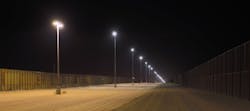DOE updates outdoor lighting study in the harsh Arizona desert
LED-based outdoor lighting installed along the US border fence near Yuma, AZ is demonstrating a higher level of illuminance variation than anticipated, with the harsh environment the probable cause.
The US Department of Energy (DOE) has released an updated report on the ongoing trial of six LED-based area luminaires installed along the US-Mexican border in the Yuma, AZ area. The trial was in part planned to test solid-state lighting (SSL) performance in an environment with temperature extremes and other environmental challenges. After 5000 hours of outdoor lighting operation, illuminance has varied more than anticipated and the DOE plans further investigation to determine the cause.
We last covered the Yuma outdoor lighting project back in December of 2014. That article was based on the Yuma Phase 1.0 Report that focused on a comparison of the photometric performance of the LED fixtures with quartz metal halide (QMH) luminaries used along the border fence. The SSL poles performed favorably based on the early testing while also delivering energy savings and anticipated maintenance savings.
Evidently, however, the DOE further evaluated the data gathered in December after the lights had operated for 2500 hours, and more recently recorded another set of data after 5000 hours of operation. The new Yuma Phase 1.1 Report suggests some variations in illuminance that exceed expectations. The variations may or may not be unacceptable, but that ideally would be explained in terms of cause.
The new report indicates that both the total light output and the distribution of illuminance is changing. The illuminance of the outdoor lighting near the poles has actually increased relative to the data recorded when the lights were initially installed. The report didn’t address the increase specifically, but other testing of LED-based products has documented that lumen output can rise early in a product's life before lumen depreciation commences.
The problematic data in Yuma comes as the measurements were taken further from the poles. The most critical area in terms of required visibility in the application is the area near the primary fence. And the new data suggest that horizontal illuminance decreased by 18% at the fence while vertical illuminance decreased by 25%.
The changes in illumination can’t be attributed to normal lumen depreciation. Such degradation of an LED light source would generally have resulted in uniform changes in illuminance across the entire measurement area. Moreover, the test results indicate no change in color over the course of a year and 5000 hours of operation, indicating that the problem may not be associated with the LEDs used in the luminaires.
The installed outdoor lighting has been operating with no maintenance for a year. The DOE suspects that the changes could be due to dirt accumulation or to changes in the optics as a result of temperature extremes. The report notes that the luminaires are subject internally to the heat from the LEDs and drivers during nighttime operation, to high ambient temperatures externally during the day, and to long days of direct solar radiation.
In an attempt to determine the cause of the variation, the DOE will pursue several angles. Researchers at the Pacific Northwest National Laboratory (PNNL) will run thermal simulations on the luminaire design. The team will remove one or more luminaires from the site for a detailed laboratory analysis. Moreover, the team plans to further monitor the outdoor lighting installation site to better understand the environmental elements such as dirt, wind, and other site-specific effects.
Monitoring LED-based lighting for long-term performance has become increasingly important as the technology matures. The DOE is performing such research in both the lab and in field tests. The agency has data on a Kansas City, MO street light project going back to 2011. And in the indoor lighting area, the DOE has ongoing reliability tests on LED-based A-lamps and on chromaticity and lumen maintenance of PAR38 lamps.
You can find more information on the report at the DOE website.

Maury Wright | Editor in Chief
Maury Wright is an electronics engineer turned technology journalist, who has focused specifically on the LED & Lighting industry for the past decade. Wright first wrote for LEDs Magazine as a contractor in 2010, and took over as Editor-in-Chief in 2012. He has broad experience in technology areas ranging from microprocessors to digital media to wireless networks that he gained over 30 years in the trade press. Wright has experience running global editorial operations, such as during his tenure as worldwide editorial director of EDN Magazine, and has been instrumental in launching publication websites going back to the earliest days of the Internet. Wright has won numerous industry awards, including multiple ASBPE national awards for B2B journalism excellence, and has received finalist recognition for LEDs Magazine in the FOLIO Eddie Awards. He received a BS in electrical engineering from Auburn University.





